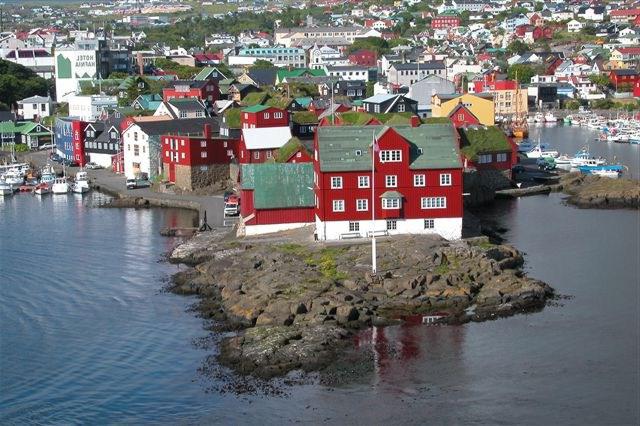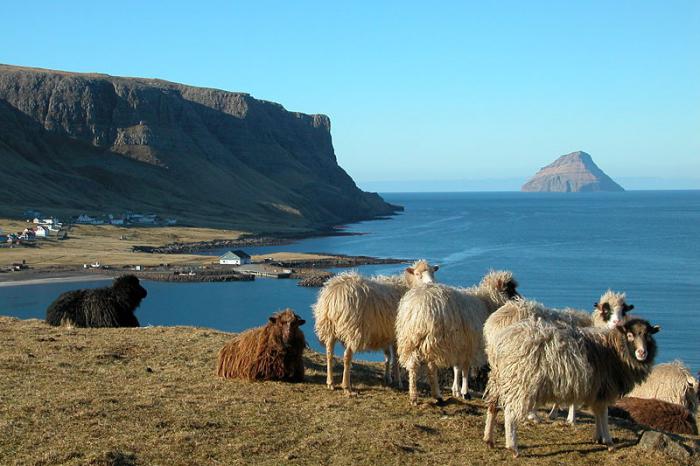The Danish Embassy in Russia issues a Schengen visa to citizens upon special request with a special note: "Valid for entry to the Faroe Islands." "Where is it?" - we are perplexed. The small Kingdom of Denmark, it turns out, also has colonies. True, not tropical, and not far from the metropolis. Well, let's say, not quite a colony: the islands have their own parliament, which decides on virtually all state issues, except for foreign policy and defense. About where the Faroe Islands are, what this archipelago is, who inhabits it and so on - read this article. We will try to talk about the natural attractions of the region and how you can get there. You will also learn interesting facts about the history and nature of the archipelago.
Where are the Faroe Islands
Locals call their archipelago Foglard. Translated, this means "sheep's islands." The breeding of this small cattle, along with fishing, has long been the backbone of the local economy. Now the number of sheep totals about eighty thousand individuals. Eighteen islands form an archipelago in the northern Atlantic Ocean called the Faroe Islands. Where is it in more detail? Between Scotland and Iceland. To Reykjavik from the Faroe Islands is approximately 450 kilometers, to the coast of Norway - 650, and to the capital of Denmark - Copenhagen - as many as 1117. In this northern region, the population is small and nationally homogeneous. Even in the capital, the city of Torshavn (Streimoy Island), only nineteen thousand people live. The second largest city, Klaksvik, has five thousand inhabitants. And there is such an island where only one person constantly lives. This is Coltur. On others - 6-11 inhabitants. Faroese make up 91.0% of the total population. Another 6 percent consider themselves Danes. In this region, for obvious reasons, quite a few immigrants.

Climatic characteristics
Where the Faroe Islands are located, the weather does not please residents with a cloudless sky and warm sun. The climate here, in view of the high latitudes, is rather severe. Strong winds blow all year round, making the landscapes on the archipelago treeless. There are only artificial plantations of conifers, mountain ash and maple. In winter it is frankly cold and damp. However, the Gulf Stream does not allow water to freeze off the coast and even maintains its temperature within +10 degrees. In summer, the air warms up to only fifteen, and it rains 280 days a year. Most precipitation falls from early autumn to January. Fogs here are not uncommon, but a norm of life.
Nature and relief
All eighteen islands have a coastline rugged by fjords. Since the archipelago is a part of the rift ridge of the Atlantic protruding above the water, their relief is very mountainous. The highest point - Slattaratindur peak, which is located on the island of Estura, climbers have been unsuccessfully trying to conquer for several decades, although its height is only 882 meters above sea level. The Faroe cliffs are composed of basaltic rocks back in the Cenozoic era. The most mountainous island - Kalsoi - all consists of sheer cliffs. Therefore, tunnels were dug to move between four small settlements. For this, as well as for the huge number of caves and sea grottoes, he was nicknamed the “flute” (Flute). And the least mountainous is Sandoi. Where the Faroe Islands are located, you do not expect to see sand dunes, but they are still there. On Sandoy you can also admire the beautiful lakes and enjoy excellent fishing.
History
Humanity has found out exactly where the Faroe Islands are located, approximately 700 years. The first settlers on this sparse vegetation archipelago came from Scotland. But at the beginning of the 9th century they were replaced by warlike Vikings. For a long time, the Faroe Islands were a transit point between Scandinavia and Iceland. Until the end of the XIV century, Norway owned the archipelago. After that, she shared her dominion over the islands with Denmark. In 1814, the latter became the sole owner of the archipelago. When the Nazi forces began the occupation of Denmark, Great Britain in the person of Prime Minister Winston Churchill ventured a retaliatory strike. In April 1940, an English cruiser embarked on a raid in the port of Torshavn. The islands were never captured by the Germans. In 1945, the British left the archipelago. In 1946, a plebiscite was held on the withdrawal of the Faroe Islands from Denmark. Parliamentarians were invited to negotiate in Copenhagen. As a result, an agreement was reached on a very broad autonomy within the Kingdom.

How to get to the Faroe Islands
The archipelago has only one international airport. It is located on the island of Voar. Its area is 177 km², and the population is three thousand people. With the capital and the largest island of the archipelago - Streim - Voar is connected by a five-kilometer tunnel dug under the bottom of the sea. The transport connection between the settlements is excellent. Old roads along mountain streamers are now increasingly replaced by underground tunnels. Ferry crossings do not allow even residents of Mykines and Stour-Duymun, whose population is eleven and six people, respectively, to feel completely isolated from the world. But tourists come here just to feel at the edge of the earth, where the Faroe Islands seem to go into the boundless expanse of the ocean. You can get to the archipelago from the airports of Copenhagen (Denmark), as well as Bergen and Stavanger (Norway). In summer, the ferry runs. He sets sail from Bergen and arrives in the capital Torshavn.
Culture
Existence at the “end of the earth” led to the emergence of very distinctive traditions. Until the 18th century, the Faroese language was unwritten, but the ancient oral epic was preserved. Also on the islands you can admire a large number of medieval churches. Residents are very careful about their original culture and regularly hold music festivals. Tourists should definitely buy products from the excellent wool of local sheep, as well as try cod soup and jerky whale meat - signature dishes that are famous for the Faroe Islands. Football takes a special place in the life of the islanders. The team was formed in 1930 and immediately lost to the Latvians. But the defeat did not disappoint the inhabitants of Faroe. In 1988, FIFA accepted the team into its composition, and in the 1990s it was recognized by UEFA.